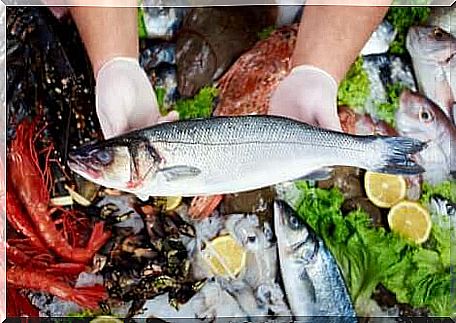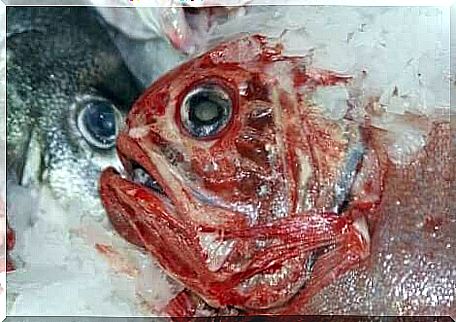Mercury In Fish And Its Effects

Nutrition experts regularly remind us how fish is an important source of essential nutrients. However, there are some fish species that are particularly high in heavy metals such as mercury. In this article, we look at the topic, as well as how mercury in fish affects humans.
According to the World Health Organization, people are exposed to these toxic compounds mainly by eating fish and shellfish. These chemical compounds affect our health and pose a significant risk, especially to pregnant and lactating women.
Why avoid certain fish species?
It has been known for years that a wide variety of marine species, especially those at the end of the food chain, collect metals such as cadmium, lead and mercury from, inter alia, the mining, livestock and agricultural sectors. The accumulation of mercury in fish is very harmful to human health.
Concentrations can become so high that a person can die from them. In fact, the mass poisoning in the Gulf of Minamata in Japan in the early 1950s is the best-known mercury poisoning in which the mercury that entered the human body came from fish.

Mercury in fish: effects on human health
According to a study published in the Chilean medical journal, the toxicity of mercury in fish and its effects are related to the chemical form, type, exposure dose and age of the substance. When a metal is released into the environment, it goes through several stages and participates in cycles between the atmosphere, water, and the earth.
About 5% of the elemental mercury enters the water (including lakes, wetlands, estuaries and oceans) and accumulates in different layers of the bottom. Bacteria living there convert it into methylmercury, which is eaten by worms and other aquatic organisms.
This is the organic matter that fish use as food. It is a highly toxic substance that damages the following organs, among others:
- Nervous system
- Immune system
- Kidneys
- Digestive system
- Lights
- Skin
- Eyes
Fish species that should be avoided
Certain fish species can live for more than 100 years. Their longevity increases their toxicity potential.
There are also large fish that eat large numbers of smaller fish. Keep reading, we’ll tell you what types of fish you should avoid.
Mackerel (Scomberomorus cavalla)
Mackerel is a sea fish with an elongated body. It has a sharp snout and a wide mouth. It also has large eyes surrounded by a bony ring. Small scales cover its entire body and have a bright blue-green back, light green sides and a silver belly.
Normally it is about 65 centimeters long, but males can be bigger. This species lives in the Atlantic Ocean, stretching from Canada and Massachusetts (USA) all the way to Sao Paulo (Brazil).
Blue marlin (Makaira nigricans)
This species can grow from 160 cm to 3 m in length. Blue marlin is also known by other names such as “blue marlin” or “Atlantic blue marlin”. However, the abdominal area is silvery white.
It has an elongated body and two dorsal fins. Its upper jaw is sword-shaped. This fish usually lives in the subtropical and tropical waters of the Atlantic, including the coasts of the Canary Islands.
It is also found in the Pacific Ocean and the Indian Ocean. Females weigh up to 450 pounds, while dogs do not usually grow to more than 350 pounds.
Orange roughy (Hoplostethus atlanticus)
This sea fish lives on the east and northwest sides of the Atlantic Ocean, south of the Pacific Ocean and the Indian Ocean. Its body is oval and flat. It has a large head, small eyes and small teeth. Fishermen recognize this species for its dark orange and red colors.
This species of fish lives at a depth of about 180 to 1,500 meters, so fishermen come across representatives of this species only occasionally. This species of fish is one of the longest-lived, it can live up to 180 years.

Atlantic cod (Gadu morhua)
Cod, also known as “Atlantic cod” or “Norwegian cod,” is one of 60 fish species that migrate from one area to another. It lives in the Northeast Atlantic Ocean from the Barents Sea to the Bay of Biscay, including the waters of Iceland, Greenland and the Baltic Sea.
It is usually a small fish, although some individuals can grow up to 80 inches tall and weigh a maximum of 100 pounds. They feed on other fish species such as herring or sardines. This species lives at a depth of about 600 meters.
Bigeye tuna (Thunnus obesus)
Bigeye tuna is one of the fish species that can contain significant amounts of heavy metals. It should be noted, however, that this is not the case for Mediterranean tuna.
Bigeye tuna live in the tropical and subtropical regions of the Atlantic, Indian and Pacific Oceans, but is not found in the Mediterranean. It has a maximum length of 12.50 meters, but usually grows to about 1.80 meters in length and lives to be about 15 years old.
Mercury in fish – summary
Some fish species that easily accumulate heavy metals, especially methylmercury, have been mentioned above. In addition to these, there are other fish species that accumulate various toxic compounds, but in the above, dangerous mercury concentrations have been most commonly tested.
Women of childbearing potential, pregnant women, nursing mothers and children under 2 years of age are more exposed to the negative effects of these toxic compounds, especially mercury. Of course, this does not mean that they do not affect other sections of the population.
However, it is good to remember that eating fish in moderation does not harm us. Fish is an important part of your regular diet! However, it is a good idea to try to avoid species where more mercury is found than normal concentrations.









